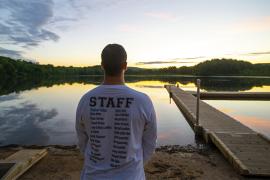If you attended camp as a child prior to 2007, the likelihood is that your parent or guardian asked the camp director how much it cost and how long you would be away.
Your parent(s) may have mentioned another camper who they considered a poor influence, or perhaps an allergy you had — and that was about it. Parents loved their children just as much then as they do today, but there was a degree of blind faith in camp to do the right thing and keep campers as safe as possible. Fast-forward to 2007 and the advent and mass distribution of smartphones followed shortly thereafter by tablets, and suddenly we were awash with information overload. That information included the proliferation of scary stories, gun violence, and abuse and ushered in the era of parental desire for monitoring of and constant contact with their offspring.
Little did we know that by 2022 smartphone penetration would surge to 91 percent (Oberlo, 2023). Add to this the remarkable miniaturization and increasing sophistication of tablets, laptops, and connected watches, and it is fair to say that today we are fully integrated. Arguing about whether we should have ever gone down this road is pointless — personal technology is here to stay.
Tech is now so ubiquitous that it is increasingly hard to escape its grasp. On a plane, in a classroom, or while we are taking care of our most private business, our miniature machinery is never more than an arm’s length away. This brings us to camp and the reality that while some see it as an escape from the connectedness of the real world, others are unwilling to separate from the digital world.
Those of us in the camp industry must also take some degree of responsibility for encouraging the cultural shift that nurtured the intrusion of tech into our day-to-day camp lives. For example, we routinely post hundreds of pictures a day of campers and staff, which is wonderful public relations. In doing so, however, we have conditioned parents to expect a window seat into a previously private world. Everything has its pluses and minuses, and while some parents find images of their children comforting, for others it reinforces the need for access and constant oversight. Many camps now report phone calls from parents having observed that their child has a Band-Aid, is not smiling, or the staff in the background do not appear engaged. The message here is that for every well-meaning action there is a subsequent reaction — and now is the time to make some purposeful decisions.
A Surprising Survey
In the summer of 2023, the consulting firm Immersive1st undertook a survey related to the use of tech at camp, receiving more than 200 responses during the height of the summer camp season. The survey clearly hit a nerve, and the narrative responses and feedback reinforced that this is a real issue for which no roadmap has been drawn.
What is the technological impact for camp programs? Here are some interesting results from the survey. Figure 1 shows the respondent breakdown, with a total of 208 participants from a broad range of camps, the majority being in the nonprofit sector (75 percent).
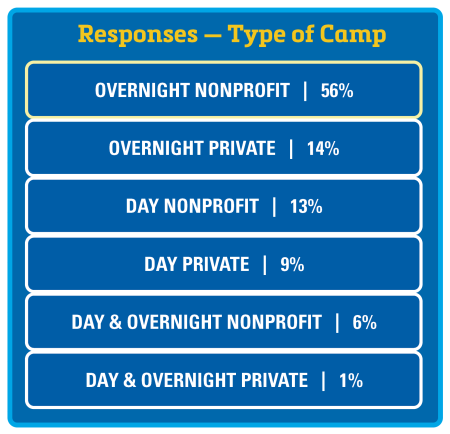
Figure 1
Campers
The majority of camps do not permit campers to use cell phones, tablets, and laptops (see Figure 2). However, feedback suggests that as campers age up, it is increasingly difficult to prevent such use, and some camps are allowing “phone time.” And regardless of rules, campers are increasingly bringing these devices to camp (often with parental approval/knowledge). This in itself is a challenging behavioral issue to deal with and is likely only to increase over the coming years. In terms of pressure from parents to relax these rules and allow access to tech for their children, 8 percent of camps felt a great deal or a lot of pressure to change, and 46 percent felt no pressure at all. While today’s cell phone usage at camp of 10 percent may not appear excessive, it is worth remembering that not so long ago camps were insistent that photography was intrusive. It is difficult to imagine a scenario in which these numbers do not shift over time — but by how much is the question. To forbid, embrace, or ignore technology use among campers is an issue to tackle now with the understanding that to ignore it is likely naïve.
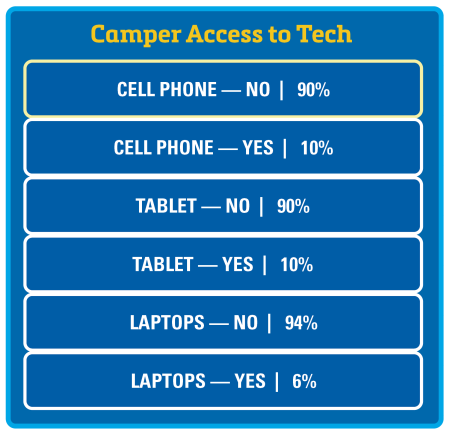
Figure 2
Camp Counselors and Other Staff
The split between staff cell phone use and nonuse during active camp is essentially 50-50 (see Figure 3). Tablet and laptop use trail behind but still hit the benchmark of at least one third for staff user access. These are stunning numbers considering the camp industry dates back to the late 1880s (Eells, 1986), and smartphone access is barely 15 years old.
Not only is usage growing, but so is its impact on staff dynamics, with over 25 percent of camps indicating that the use of tech impacts mission, vision, and operations (see Figure 4). But what are the practical implications of staff tech usage?
The Cell Phone Quandary
Research indicates that cell phones can be addictive. There is even a term for it — nomophobia, which stands for “NO MObile PHone PhoBIA” (Bhattacharya et al., 2019). In fact, Pew research found that 45 percent of teenagers feel addicted to their smartphone devices (Schaeffer, 2019). As those teenagers age and become our young-adult staff, is it any wonder that giving them up is emotionally challenging? Interestingly, the same study indicates that 54 percent of teenagers worry they spend too much time on their devices. Camp is one of the last places where it might be possible to limit or eliminate usage on at least a temporary basis.
In truth, any notion of total cell phone elimination is probably in the rear-view mirror. Staff will demand access to their phones at least during their time off or after their campers are tucked in for the night. Some camps now even encourage staff to use their cell phones, mostly under the guise of safety.
It can be argued that cell phones are the fastest means of alerting leadership to a problem. It is also fair to say that off-campus trips benefit from cell phones (or a satellite phone) and make good sense. However, on camp grounds, the majority of operators have a robust walkie-talkie system and phones available to report a problem, so there is already a safety net that does not require additional technology.
If you are most concerned about your camp’s riskiest program areas having cell phone access, it is worth noting that these areas — waterfront, adventure/ropes course, kitchen, health center — should already have your most qualified personnel trained to cope with emergencies. Therefore, having all-staff access to cell phones in these locations may not be necessary.
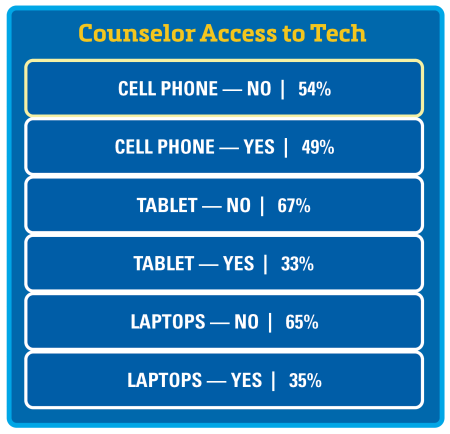
Figure 3
A decision to allow cell phones at camp generates extemporaneous issues. For example, the taking of unauthorized and easily shared photographs. This represents a risk to the camp if such photos are not monitored for appropriateness, location, or permission. Imagine pictures taken inside a cabin that include people or items that are not intended for general distribution. The posting of images or commentary to social media without administration being aware was mentioned in narrative survey comments as troublesome and difficult to prevent. This does not mean that the person taking or posting images or messages deliberately crossed the boundary of illegal or illicit behavior, but some images may be intrusive and inappropriate.
Moreover, while a camp has modest control over their use, if you allow or even require cell phones for safety purposes, you have sanctioned the use of devices that are fundamentally designed for sharing information. This could result in your hard-fought reputation and senior staff being impugned in the community because of a media post. You might not even know about it unless someone contacts you directly. For want of a better metaphor, as Humpty Dumpty found out, once the egg has been scrambled it cannot be put back together again. Social media could potentially compromise camper safety — and that goes directly to the reputation of your program and its leadership.
The impact of these devices on the young adults to whom we give the awesome responsibility of caring for and ensuring the safety of children is also a concern. A staff member could get engrossed in their screen just when something happens to a child. Based on narrative feedback from the survey, camp administrators are concerned about staff being distracted from their duties. With cell phone usage blamed for 26 percent of our nation’s car accidents (Kratsas, 2014), it isn’t difficult to extrapolate that the distraction caused by cell phones at camp could result in a loss of concentration while watching over campers. We should consider the impact of this on staff mental health as well as the physical care of campers.
Other issues to consider include that if you sanction the use of these expensive devices “for camp safety” and they get broken or lost, you may be liable for their replacement or repair.
Feedback indicates that once cell phones are a systemic part of camp life it is virtually impossible to limit use to safety only. As in the real world, communications may include items that are outside of camp administration’s expectations. For example, some have reported texted gossip, bullying behaviors, and unflattering comments among campers and staff. In some cases, important information that should have been shared with camp administration was discussed openly in staff-only social forums. Instances of problematic mainstream social media posts were also cited. These “chats” often included items internal to camp shared with those outside, and they sometimes found their way to parents before the camp had a chance to calibrate its own messaging.
Some camps additionally indicated that they regularly stream movies, but as we know, the internet is not all good, clean fun. It could lead to a world of problems should viewing parties cross a line into R-ratings or worse.
To be clear, technology is not bad, and camps are increasingly reliant on it for essential functions such as enrollment, medical monitoring, and parental outreach — all of which are terrific additions and often time-saving applications. But managing the overall use of technology at camp is an increasing challenge and may mean searching for a balance between allowing staff and campers to have access to technology for their enjoyment and not letting it interfere with the camp experience or create safety concerns.
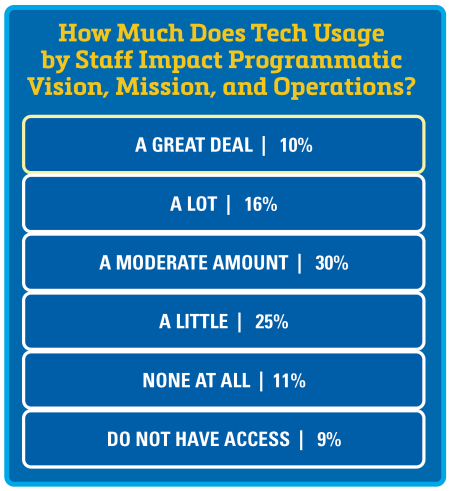
Figure 4
Camp was designed to be a sanctuary away from everyday life, and that is needed today more than ever before. It is a place where we can temporarily block the news and toxicity that can percolate in the real world. Think about your camp’s technology policies, and consider discussing these key questions with year-round colleagues, camp staff, and board members:
- Does the use of mobile communication technology (cell phones, tablet, laptops) by staff and/or campers meet your mission?
- What is the impact on young adults and children (not on your camp) of having or not having access to these devices during the summer?
- What will your camp program look like in 5 to 10 years based on your decisions related to technology today?
Making a proactive decision is critical. Can you reverse a decision and change how you approach the use of tech? Absolutely, because that is the magic of what we do. We adapt and change based on the needs of our camp community. At the very least, now is the time to discuss the issue.
If you are interested in gaining access to the Immersive1st survey, contact the author at [email protected].
References
Bhattacharya et al. (2019, April). NOMOPHOBIA: NO Mobile Phone PhoBIA. Journal of Family Medicine and Primary Care. journals.lww.com/jfmpc/Fulltext/2019/08040/NOMOPHOBIA__NO_MObile_PHone_PhoBIA.2.aspx
Eells, E. (1986). History of organized camping: The first 100 years. Martinsville, IN: American Camp Association.
Kratsas, K. (2014, March 28). Cellphone use causes over 1 in 4 car accidents. USA Today. usatoday.com/story/money/cars/2014/03/28/cellphone-use-1-in-4-car-crashes/7018505/
Oberlo. (2023). How many Americans have smartphones (2013—2023). oberlo.com/statistics/how-many-americans-have-smartphones
Schaeffer, K. (2019, August 23). Most US teens who use cellphones do it to pass time, connect with others, learn new things. Pew Research Center. pewresearch.org/short-reads/2019/08/23/most-u-s-teens-who-use-cellphones-do-it-to-pass-time-connect-with-others-learn-new-things/
David Phillips is principal of Immersive1st, a firm specializing in fundraising, planning, visioning, governance, acute organizational analysis, and program creation, implementation, and evaluation. His passion is doing important things with good people who make a difference (and having fun while doing it). He holds an MSW in Social Work with a focus on community organizing and development from the University of Pittsburgh. David can be reached at [email protected] or via the web at immersive1st.com.

